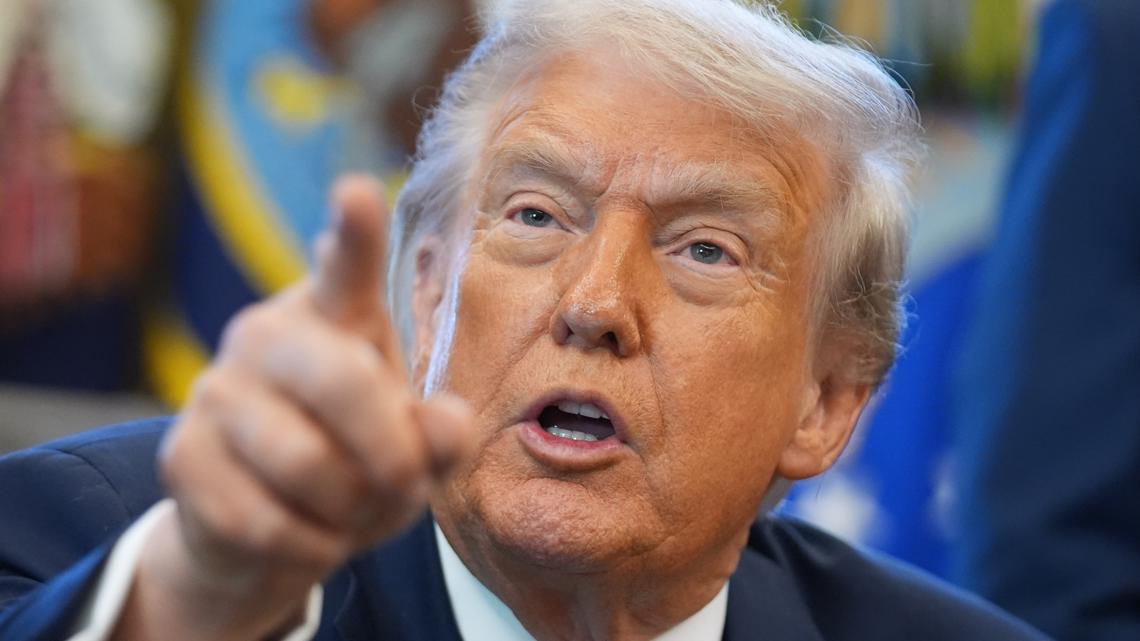The Republican president doubled down on his proposal on Monday, even setting a timeline for the $2,000 rebate checks.
WASHINGTON — President Donald Trump has given a timeline for his proposed $2,000 rebate checks from tariff revenue.
His comments come after Treasury Secretary Scott Bessent confirmed that they could go out, but the proposal would need congressional approval first. On Monday afternoon, the president doubled down on his plan and gave more details about the checks.
While answering questions in the Oval Office, Trump said Americans can expect the checks around mid-2026.
“We have thousands of dollars for individuals of moderate income, middle income. We are going to pay down debt,” he said to reporters. “We have a lot of money from tariffs; if we didn’t have tariffs, this country would be in serious trouble.”
Just a day prior, Bessent said the checks would be “for working families” and would have an income limit.
The president’s latest call to send checks to the American people comes as the Supreme Court mulls whether Trump’s sweeping tariffs are even legal.
In a hearing earlier this month, the justices sounded skeptical about the Trump administration’s assertion of sweeping power to declare national emergencies to justify the tariffs. Trump has bypassed Congress, which has authority under the Constitution to levy taxes, including tariffs.
If the court strikes down the tariffs, the Trump administration may have to refund the tariffs to importers, making dividend checks to American families no longer even a possibility.
The Treasury secretary said Sunday he doesn’t think the Supreme Court would rule against the tariff policy.
“I don’t think this ruling is going to go against us,” he said. “But if it does, what’s their plan for refunds? Because how is this going to get to consumers? Are they gonna hand some of these importers big windfalls?”
“I don’t think the Supreme Court wants to wade into a mess like that,” he added.
Who will get Trump’s $2,000 tariff rebate checks?
While the Trump administration has confirmed its commitment to the president’s plan, no official details have been outlined on what it could look like.
Bessent said the checks would be for “working families” and would have income limits. The president also said that the checks would be for “moderate” and “middle” income families.
Still, Trump would need Congress to pass legislation to distribute the checks. As of right now, that seems an extreme long shot.
In July, Republican Sen. Josh Hawley introduced the American Worker Rebate Act for a stimulus check, but the idea has fallen flat among his colleagues in the Republican-controlled Congress. Several Republican senators shot down the tariff rebate check plan publicly, calling the proposal everything from “a bad idea” to “insane.” Most conservatives instead want to use any tariff revenue to pay down the massive national debt.
Trump has boasted that “trillions of dollars” are coming into the U.S. from tariffs, but budget experts say the math doesn’t quite add up.
John Ricco, an analyst with the Budget Lab at Yale University, estimates that Trump’s tariffs will raise $200 billion to $300 billion in annual revenue. But a $2,000 dividend — if it went to all Americans, including children — would cost $600 billion.
“It’s clear that the revenue coming in would not be adequate,” he said.
As of Sept. 30, the federal government had generated $195 billion in tariff revenue.
What happened to Trump’s DOGE dividend checks?
This isn’t the first time Trump has pushed the idea of a payout for Americans due to his policies.
In February, the Republican president said he liked the idea of giving some of the savings from Elon Musk’s Department of Government Efficiency, or DOGE, back to Americans as a dividend.
At the time, Trump said his administration was considering a plan in which 20% of the savings from DOGE federal budget cuts would go to U.S. citizens, and the other 20% would help pay down the national debt. The plan never materialized, and months later, Musk left the DOGE office.
